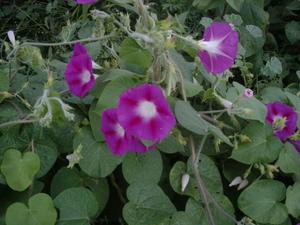Rising early one Saturday morning, I sauntered around my garden while “talking to the plants” and admiring most of them for having grown full and well a few months since my husband and I planted them. Some plants take only a few months to be fully grown, while others take years to grow to their potential size. Actually, garden plants can be grown to flowering stage in a short period of time. How? By using cuttings in three easy ways.
Using, as a tangible example, the roots growing from a flowering plant’s stem that has remained in a vase for some time, it is easy to understand how one can grow her garden plants faster by doing any of the three ways of using cuttings; one therefore doesn’t really have to wait for the seeds to sprout and grow.
Of the three, stem cuttings is the most commonly used way of propagating garden plants. Here, the gardener begins by selecting a healthy growing plant; she then makes the cut from the thickest, green non-flowering stems of the plant. The best cutting is the area near the nodes, or the spot where a leaf is attached to the stem, as it is in this stem area where the growth hormones of a plant is concentrated.
Two cuts are made, one just below a node and the other, done slanted, about 10 centimeters farther up. These cuts should produce a cutting that is about 10 centimeters in length and with at least two nodes, one of which should be just below the upper tip. The side shoots of the cutting are trimmed off and its leaves, except for a few, are removed; the cutting is stressed and its rooting slowed down by the wilting of the leaves.
To bring rooting back to speed, the lower part of the cutting is dipped in hormone powder. The cutting is then inserted in a hole made in the moist potting soil in the planter that has been prepared earlier, making sure that the cutting remains firmly upright while the powder stays on it. The planter, with cuttings planted about half a foot apart from each other, is then placed on a brightly-lit spot in the garden; the soil is kept moist.
An indication that the cuttings have grown roots is when they resist being pulled out. This is when they should be transplanted into individual pots and allowed to continue growing under bright light. When the pots are filled with roots, the cuttings (now new plants) are ready to be transferred to the garden plot.
In propagating some overgrown, leggy plants with thick stems, cane cuttings is preferred. In this method, the gardener cuts leafless stem sections, each about 5 centimeters long, from older stems of a plant. Each of the cut stem sections (cane) should have at least one node. With a bud facing upward, the cane cuttings are planted horizontally just beneath the ground. The appearance of shoots indicates that the cane cuttings are ready to be moved to individual pots.
Leaf cuttings is the third way and is seldom used. This method may be used in propagating some ornamental plants. Here, the gardener makes use only of the leaf blade and about a centimeter portion of the petiole (the footstalk of a leaf). The rest of the procedure follows those in the first two ways.
One good thing about propagating plants using any of the three ways of cuttings is that a greenhouse is not really required. Of course, the gardener’s success depends largely on her maintaining a high humidity around the plants.
Sources: http://www.ces.nesu.edu/depts/hort/hil/hil-8702.htm/ and http://www.anbg.gov.au/PROPAGATE/propagat.htm



